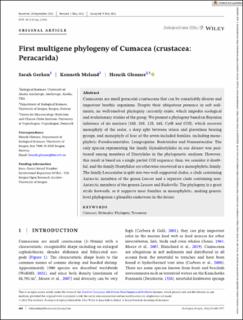First multigene phylogeny of Cumacea (crustacea: Peracarida)
Journal article, Peer reviewed
Published version

Åpne
Permanent lenke
https://hdl.handle.net/11250/3061870Utgivelsesdato
2022Metadata
Vis full innførselSamlinger
- Department of Biological Sciences [2235]
- Registrations from Cristin [9791]
Sammendrag
Cumaceans are small peracarid crustaceans that can be remarkably diverse and important benthic organisms. Despite their ubiquitous presence in soft sediments, no well-resolved phylogeny currently exists, which impedes ecological and evolutionary studies of the group. We present a phylogeny based on Bayesian inference of six markers (18S, 28S, 12S, 16S, CytB and COI), which recovers monophyly of the order, a deep split between telson and pleotelson bearing groups, and monophyly of four of the seven included families, including monophyletic Pseudocumatidae, Lampropidae, Bodotriidae and Nannastacidae. The only species representing the family Gynodiastylidae in our dataset was positioned among members of Diastylidae in the phylogenetic analyses. However, this result is based on a single partial COI sequence; thus, we consider it doubtful, and the family Diastylidae are otherwise recovered as a monophyletic family. The family Leuconidae is split into two well-supported clades, a clade containing Antarctic members of the genus Leucon and a separate clade containing non-Antarctic members of the genera Leucon and Eudorella. The phylogeny is a great stride forwards, as it supports most families as monophyletic, making generic level phylogenies a plausible endeavour in the future.
